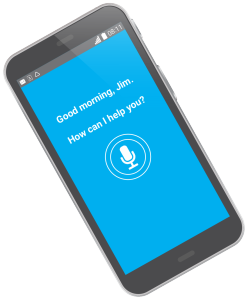 My smartphone is smarter than I am. It’s brain is broken up into eight processing circuits. Six of the processors are for general computing—making phone calls, playing games, tweeting and all the other smartphone wizardry we take for granted. There are two special processors, though, which are a different. One circuit is a little bit of genius. It is a natural language processor. It is always on, always listening, always ready to understand speech. It allows me to talk to the phone without touching it.
My smartphone is smarter than I am. It’s brain is broken up into eight processing circuits. Six of the processors are for general computing—making phone calls, playing games, tweeting and all the other smartphone wizardry we take for granted. There are two special processors, though, which are a different. One circuit is a little bit of genius. It is a natural language processor. It is always on, always listening, always ready to understand speech. It allows me to talk to the phone without touching it.
Humans have wiring in their brains—natural social processors—that interpret complex social interplay. Without conscious thought, this special purpose circuitry subtly decodes the meaning of numerous social cues: the choice of words (casual or formal, welcoming or off-putting), changes in tone (ending a sentence higher to welcome collaboration, or lower to indicate authority), the accompanying facial expressions (smiles, frowns, brow-furrowing, cocked eyebrows), gestures (folded arms, outstretched hands, shoulder brushing), body positioning (angling towards the welcomed, or away from the shunned), and many more. This processor is always on, always ready to help humans understand each other’s behavior.
A smartphone doesn’t need the a dedicated circuit to listen to speech. Most phones use general processors for this special purpose. For instance, the latest iPhones allow you to talk to them without pressing a button just by saying, “Hey, Siri.” But using general-purpose hardware as a natural language processor is inefficient. It’s a force fit which uses much more power. That’s why you can only talk to an iPhone this way when it’s plugged in. When running on battery, you have to press a button to tell the iPhone you intend to talk to Siri. Only then does the phone start listening. The result is a little rough around the edges.
Being autistic, I don’t have the same specialized social circuitry most humans are born with. When I need to, with great conscious effort, I make use of the same observational capabilities that I use for the rest of the universe—my general purpose processors—and direct them towards people. It takes a lot of energy, so I only do it when I need to, pressing the button to explicitly engage the circuit. And the result is a little rough around the edges.
It has only been within the last decade that I can passably understand social situations. After fifty years of careful observation, I have models in my mind that make sense of the humans around me. I catalog the words people used. I correlate the tone of speech to the resulting behavior to extract patterns. I note the accompanying constriction of facial muscles, the rigidity of unintentionally awkward shoulder clasping, and the smiles that lack satisfactorily convincing crinkling around the eyes. I recognize different types of conversational interruptions: exuberant eagerness, for instance, is preceded by apologetic hand gestures, while rude superiority is not.
Before I had created these models I stumbled. I blundered. I hid. I was walking—blind—in a nighttime forest so I moved about only when I had to. I still ended up bruised by trunks I would collide with, or scraped raw by the low-hanging branches, battered by an invisible social environment.
My models are a flashlight that I flip on—with significant intentional effort—to find my way through the dark forest: a narrow illuminating cone I use to avoid the most obvious trees and the most threatening eye level branches. Still, I might point the beam in the wrong direction or trip over roots and other subtle obstacles I never thought to look at. For most humans, this is a daytime forest. The light is always on. They’ve never had to fumble for a switch, never had to consider the darkness.
By now I am generally comfortable with social interaction. But each encounter has a cost. In engaging, my brain is burning brightly, consuming mental fuel at an alarming rate. I would be foolish to do this more than necessary. Dealing with people isn’t unpleasant. It’s just really tiring.
I’m still learning. My lack of innate social facility might not be noticeable in casual conversation, or in the well-scripted work environment, but my conscious emulation of a social processor—cobbled together from general purpose parts—can’t pass for the real thing on close inspection. People that know me well catch the fake smiles. They recognize my graceless interruptions as unintentional. Those that accept—or even enjoy—my awkward differences are my friends. If I am with them, and not paying attention, they say, “Hey, Jim.” They make sure I’m plugged in.

Be grateful you have friends. I have not mastered how that works. At 54 I am still uncomfortable in social situations.Autism is lonely at times. I am blessed to have a husband who is understanding & is my best friend.
Paula, it is interesting how we all have different viewpoints. Myself, I don’t understand loneliness. There’s so much in the universe that captures me beyond my (extraordinarily patient and gracious) friends.